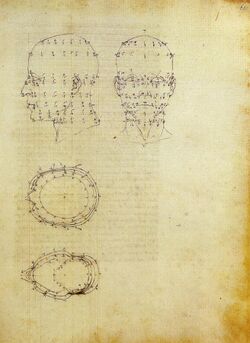De Prospectiva pingendi

De Prospectiva pingendi (On the Perspective of painting) is the earliest and only pre-1500 Renaissance treatise solely devoted to the subject of perspective.[1] It was written by the Italian master Piero della Francesca in the mid-1470s to 1480s,[2] and possibly by about 1474.[3] Despite its Latin title, the opus is written in Italian.
The book
The subjects covered by Piero della Francesca in these writings include arithmetic, algebra, geometry and innovative work in both solid geometry and perspective.[4][5]
The script consists of three parts:
- Part One Disegno, describing techniques for painting faces
- Part Two Commensurazio, describing perspectives
- Part Three Coloro, describing techniques for creating perspectives by using colours
History
De Prospectiva pingendi was probably created in the years between 1474 until 1482.[6][7][5]
The writings were inspired by the book De pictura by Leon Battista Alberti[7] and references Euclid's Elements and Optics.[2][5] The manuscript later came into the possession of the Biblioteca Palatina in Parma[5] before it was transferred to the Biblioteca Ambrosiana.
Much of Piero's work was later absorbed into the writing of others, notably Luca Pacioli, whose Divina proportione (1509) discusses Piero's use of perspective, as well featuring a translation of Piero's entire work on solid geometry, Short Book on the Five Regular Solids.
In 1899 the work was first published in book form.[8]
References
- ↑ Andersen, Kirsti (2007). The Geometry of Art. New York, NY: Springer. p. 17. ISBN 978-0-387-25961-1. https://archive.org/details/geometryarthisto00ande.
- ↑ 2.0 2.1 Livio, Mario (2003). The Golden Ratio. New York: Random House. p. 126. ISBN 0-7679-0816-3. https://books.google.com/books?id=bUARfgWRH14C&pg=PA126.
- ↑ Kemp, Martin (1990). The Science of Art. New Haven and London: Yale University Press. p. 27. ISBN 0-300-05241-3. https://archive.org/details/scienceofartopti0000kemp.
- ↑ [1], Codices Illustres
- ↑ 5.0 5.1 5.2 5.3 "Archived copy". Archived from the original on 2010-03-29. https://web.archive.org/web/20100329120658/http://emsh.calarts.edu/alumni/bkeresey/pier.html. Retrieved 2010-04-11., Computer Animation Lab
- ↑ Calter, Paul (1998). "Geometry in Art & Architecture Unit 13". http://www.dartmouth.edu/~matc/math5.geometry/unit13/unit13.html#Francesca. Retrieved December 23, 2018.
- ↑ 7.0 7.1 [2], Encyclopædia Britannica
- ↑ [3], Google Books.com
External links


